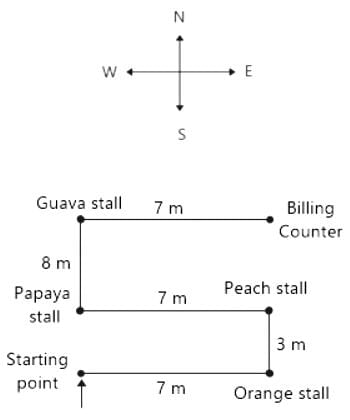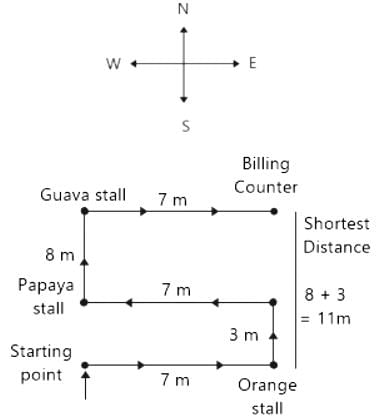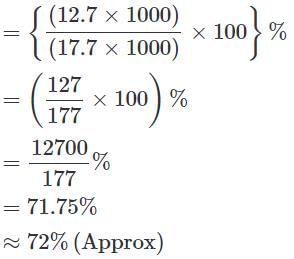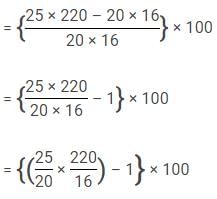SSC Selection Post Mock Test - 4 - SSC Exams MCQ
30 Questions MCQ Test - SSC Selection Post Mock Test - 4
A major telecom company recently hired a new Chief Financial Officer to take command of the company’s finances. This move came against the backdrop of national and global economic crises.
The CFO is charged with the responsibility of realigning the finances of the largest Strategic Business Unit which deals with network solutions to major corporate clients in the country. In wake of the overall financial slump, many of the corporate clients have been delaying the payment of their recurring dues for the monthly network and internet services utilised. The local account managers handling those clients and their respective Regional Managers had been given the authority to maintain client relations and if necessary allow the delayed payments with a view to continue a long-term relationship with the key clients. However, the new CFO after taking stock of the situation decided to put an affirmative end to this practice. He sent a mail to every regional and local account manager asking them to discontinue services to the defaulting clients. In spite of such a strong communication, most major clients delayed the payments in the next month. As a response to this, the CFO resent his earlier mail asking for comments. In the next month, the single largest client defaulted on the payment and the regional manager promptly asked the technology company to terminate services to that client. The regional manger merely informed the client that the delay in payment was responsible for the termination of services and the service would be reconstituted on payment of the dues.
The client faced severe difficulties due to discontinuation of the internet and local network services. The CEO of that company wrote a scathing email to the Chairman of the telecom company.
The CEO pointed out the sudden, mishandled and improperly communicated decision and its severe impact on his company’s business. He pointed out that they were one of the largest clients of the telecom company. The CEO also hinted that his company would want to reconsider their future engagement. The Chairman decided to maintain the relations with that important client and yet protect his company’s image. He promptly restarted the network services and yet requested the client to clear the dues within a week and to avoid major delays especially in these times of crisis. The client replied to this communication, agreeing to the specified norms. However, the Chairman decided to severely reprimand the Regional Manager and suspended him for 2 weeks. He also severely questioned the CFO for his error. At the next board of directors meeting, there was support for the Chairman’s action in spite of protests by some senior directors who defended the CFO and the Regional Manager's actions.
Q. The Chairman’s decision is vindicated because:
The CFO is charged with the responsibility of realigning the finances of the largest Strategic Business Unit which deals with network solutions to major corporate clients in the country. In wake of the overall financial slump, many of the corporate clients have been delaying the payment of their recurring dues for the monthly network and internet services utilised. The local account managers handling those clients and their respective Regional Managers had been given the authority to maintain client relations and if necessary allow the delayed payments with a view to continue a long-term relationship with the key clients. However, the new CFO after taking stock of the situation decided to put an affirmative end to this practice. He sent a mail to every regional and local account manager asking them to discontinue services to the defaulting clients. In spite of such a strong communication, most major clients delayed the payments in the next month. As a response to this, the CFO resent his earlier mail asking for comments. In the next month, the single largest client defaulted on the payment and the regional manager promptly asked the technology company to terminate services to that client. The regional manger merely informed the client that the delay in payment was responsible for the termination of services and the service would be reconstituted on payment of the dues.
The client faced severe difficulties due to discontinuation of the internet and local network services. The CEO of that company wrote a scathing email to the Chairman of the telecom company.
The CEO pointed out the sudden, mishandled and improperly communicated decision and its severe impact on his company’s business. He pointed out that they were one of the largest clients of the telecom company. The CEO also hinted that his company would want to reconsider their future engagement. The Chairman decided to maintain the relations with that important client and yet protect his company’s image. He promptly restarted the network services and yet requested the client to clear the dues within a week and to avoid major delays especially in these times of crisis. The client replied to this communication, agreeing to the specified norms. However, the Chairman decided to severely reprimand the Regional Manager and suspended him for 2 weeks. He also severely questioned the CFO for his error. At the next board of directors meeting, there was support for the Chairman’s action in spite of protests by some senior directors who defended the CFO and the Regional Manager's actions.
Direction: In each question below is given a statement followed by two conclusions numbered I and II. You have to assume everything in the statement to be true, then consider the two conclusions together and decide which of them logically follows beyond a reasonable doubt from the information given in the statement.
Statements: In a one day cricket match, the total runs made by a team were 200. Out of these 160 runs were made by spinners.
Conclusions:
- 80% of the team consists of spinners.
- The opening batsmen were spinners.
Statements: In a one day cricket match, the total runs made by a team were 200. Out of these 160 runs were made by spinners.
Conclusions:
Direction: In each question below is given a statement followed by two conclusions numbered I and II. You have to assume everything in the statement to be true, then consider the two conclusions together and decide which of them logically follows beyond a reasonable doubt from the information given in the statement.
Statements: Prime age school-going children in urban India have now become avid as well as more regular viewers of television, even in households without a TV. As a result there has been an alarming decline in the extent of readership of newspapers.
Conclusions:
- Method of increasing the readership of newspapers should be devised.
- A team of experts should be sent to other countries to study the impact of TV. on the readership of newspapers.
Directions: Read the given information carefully and answer the questions given beside:
Nine persons – Chaya, Dimple, Beena, Ajit, Jaya, Fatima, Gagan, Hemant and Kaushal – are sitting in a straight line facing north, but not necessarily in the same order.
Beena is fourth to the left of Gagan; Fatima is fourth to the right of Chaya and second to the left of Kaushal, who is fifth to the right of Ajit. Dimple is not an immediate neighbour of either Kaushal or Beena. There are only three persons between Jaya and Ajit. Gagan is second to the right of Chaya.
Q. In which of the following combinations is the third person sitting between the first and the second person?
Directions: Study the following information carefully and answer the given questions.
Virat goes to Supermarket store to buy fruits. He enters the market, turns to his right, walks 7m and takes oranges. Then, he turns to his left, walks 3m and takes Peach. Again, he turns to his left, which is towards west, walks 7m and takes Papayas. Again, he turns to his right and looks at guavas, which 8m away from him. He takes guavas and moves to his right, walks 7m and stops at the counter for billing.
Q. In which direction does Virat move for billing?
Directions: Study the following information carefully and answer the given questions.
Virat goes to Supermarket store to buy fruits. He enters the market, turns to his right, walks 7m and takes oranges. Then, he turns to his left, walks 3m and takes Peach. Again, he turns to his left, which is towards west, walks 7m and takes Papayas. Again, he turns to his right and looks at guavas, which 8m away from him. He takes guavas and moves to his right, walks 7m and stops at the counter for billing.
Q. What is the shortest distance between the Orange stall and the Billing Counter?
Study the following line graph and answer the questins.
Exports from Three Companies Over the Years (in Rs. crore)

Q. In which year was the difference between the exports from Companies X and Y the minimum?
15 men could finish a piece of work in 210 days. But at the end of 100 days, 15 additional men are employed. In how many more days will the work be complete?
A certain number of two digits is three times the sum of its digits. If 45 is added to it, the digits are reversed. The number is _______
The number of seats in a cinema hall is decreased by 8% and also the price of the ticket is increased by 4 percent. What is the effect on the revenue collected?
There are two shops, A and B. Shop A gives successive discounts of 60% and 40%, whereas shop B gives successive discounts of 30% and 70%. If the selling price of an article is the same in both the shops, then what is the ratio of marked prices of the article in the two shops?
Directions: Study the following table carefully and answer the questions that follow:
Semester fees (In Rs. thousands) for five Different Courses in 6 different years.
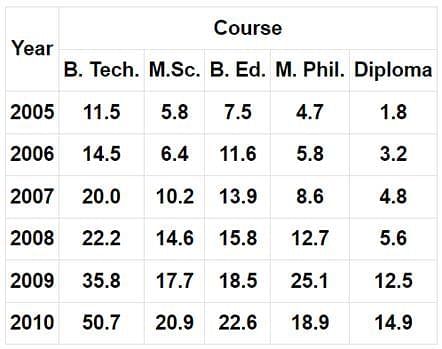
Q. The semester fee charged for M. Phil course in the year 2008 was approximately what percentage of the semester fee charged for M. Sc course in the year 2009?
Directions: Study the following bar chart carefully and answer the questions given beside.
Public Sector Outlay (in percentage) of different sectors is given below.
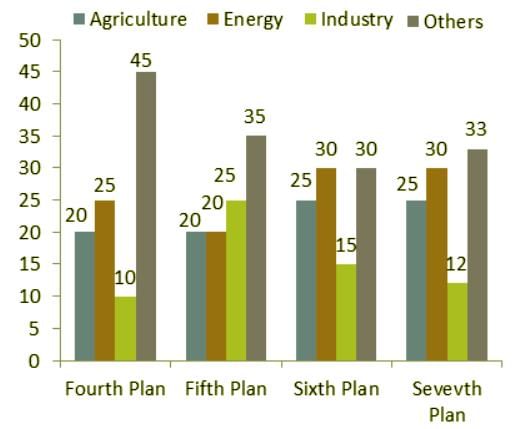
Q. In the seventh plan, the amount spent towards Industry was Rs. 26,400 crores. What was the amount spent towards Transport and Communication, if it was 40% of ‘others’?(in Rs. crores)
Directions: Study the following bar chart carefully and answer the questions given beside.
The Public Sector Outlay (in percentage) of different sectors is given below.
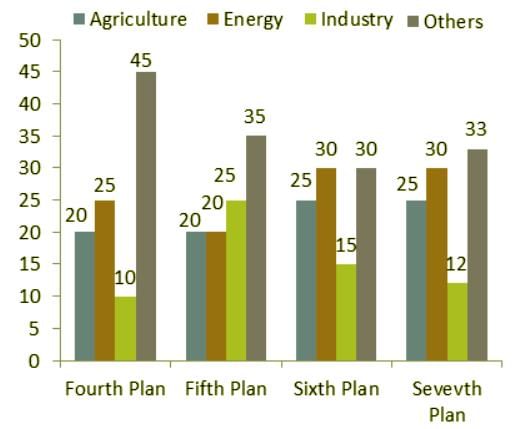
Q. During the fourth plan and the seventh plan, the total public sector outlay was Rs. 16,000 crores and Rs. 2.2 lac crores respectively. The percentage increase in deployment of funds was the maximum for which of the following sectors from the fourth plan to the seventh plan?
Directions: Study the following bar chart carefully and answer the questions given beside.
Public Sector Outlay (in percentage) of different sectors is given below.
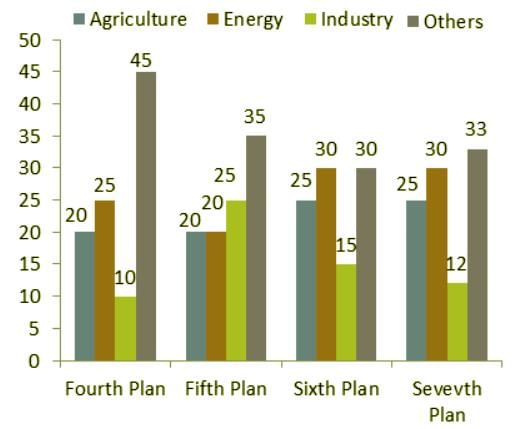
Q. Public sector outlay was Rs. 40,000 crores in the fifth plan and around Rs.1 lakh crores in the sixth plan. What is the percentage increase in the amount spent towards Energy sector from the fifth plan to the sixth plan?
Find out the Synonym of the following word:
WARRIOR
In the following questions four alternatives are given for the idiom/phrase italicised and underlined in the sentence. Choose the alternative which best expresses the meaning of idiom/phrase.
Q. He is leaving the country for good.
Each species has its special place or habitat. An (31)____ bird watcher can look at (32)____forest, meadow, lake , swamp or field and (33)____ almost exactly what birds he (34)____find there (35)____birds are found all over the world; others (36)____ themselves to certain areas. Still (37)____migrate from one country to another in (38)____in search of warmth and (39)____, and then return in spring,(40)____the season is more favourable.
Q. Find the word most appropriate for Blank No. 31
Each species has its special place or habitat. An (31)____ bird watcher can look at (32)____forest, meadow, lake , swamp or field and (33)____ almost exactly what birds he (34)____find there (35)____birds are found all over the world; others (36)____ themselves to certain areas. Still (37)____migrate from one country to another in (38)____in search of warmth and (39)____, and then return in spring,(40)____the season is more favourable.
Q. Find the word most appropriate for Blank No. 32
Doctors are loath to prescribe powerful painkillers because their abuse as addictive drugs is a danger for many patients.
Direction: In the questions given below a sentence is given with two blanks in each. Corresponding to each question two columns are given with three words in each column. Which combination of words from the two columns will perfectly fit into the blanks to make the sentence contextually correct and meaningful?
Taking a cue from these complaints, the National Human Rights Commission had ____________ a draft of patients’ rights charter with the Ministry and it was ____________ at the 11th meeting of the National Council of Clinical Establishments.

Choose the correct active voice for the given passive voice sentence:
Passive Voice: The plants were watered by John.
Directions: Read the passage and answer the questions that follow:
Paragraph 1 : The government has announced a list of ‘Institutes of Eminence’ (IoE) among India’s institutions of higher education. This was awaited for the simple reason that finding a place on it would save an educational institution from the clutches of a dreaded regulator. Regulators are meant to ensure that we have a socially desirable outcome, but in the case of higher education in India the opposite seems to have been the case. The University Grants Commission (UGC) has over half a century micro-managed this space to an unimaginable level of silliness. The result has been publicly-funded universities that are cavernous wastes, shattering the aspirations of our youth and producing low-level ‘knowledge’. Evidence of the role of India’s higher-education regulator may be seen in the feature that the few instances when this is not the case the institutions have enjoyed privilege that leaves them protected from its depredations.
Paragraph 2 : The latest offering is in the form of a proposed Higher Education Commission of India (HECI). The intention is to leave the HECI to focus on quality while leaving funding of public institutions to the Ministry of Human Resource Development (MHRD). Even as we observe the progress of the HECI and wonder if it is going to be any more than old wine in a new bottle, we already have an inkling of what could go wrong. This springs from the government’s announcement of a list of IoEs. The government has chosen three public and three private institutions for this status. The public institutions are the Indian Institute of Science, Bengaluru, and the Indian Institutes of Technology at Delhi and Mumbai. The private ones are the Birla Institute of Technology and Science Pilani, the JIO Institute and the Manipal Academy of Higher Education. This list suffers from a serious lack of credibility. Where in it are the universities of India? We understand that the government’s aim is to rectify the low presence of Indian institutions in the global rankings of universities.
Paragraph 3 : While the early European universities may have started as academies of the arts they were soon to have medicine and astronomy as areas that they pursued with vigour. Somewhere along the line we seem to have lost this breadth and come to revel in a landscape dominated by engineering schools. These engineering schools, notably the IITs, have done us proud but cannot be equated with the great universities of the world for the simple reason that they are focussed on a narrow domain. Also, if the idea behind IoEs is that they will be left alone and given enhanced financial support, it must be acknowledged that until very recently the IITs have not been meddled with neither have they been starved of resources. The IISc is of course broader than the IITs but does not embrace the social sciences and the humanities, the presence of which would be considered necessary for a university.
Paragraph 4 : If a list of eminent institutions in the country is at all needed, the absence of the Jawaharlal Nehru University (JNU) from the first list of IoEs is striking. Its faculty has brought many of the world’s leading ideas to Indian students and in at least area came close to building a new school of thought, however controversial. It is not as if similar efforts in the social sciences have not occurred elsewhere in India but JNU has perhaps sustained its reputation as a university for longer. It already had schools of Computer Science and the Life Sciences over four decades ago when these were fledgling disciplines giving it a certain breadth early on.
Paragraph 5 : Even as we may wonder at the exclusion of JNU from the list of IoEs released by the government one might wonder at how the private institutions that are on it made the cut. While BITS Pilani may have made a significant contribution to the country at a time when it desperately needed engineers, but is yet not what may be considered a university, the presence of the two others on the list leave one nonplussed. One of them, we are told, has been conferred the status on grounds of its promise, a dubious position to take as this institute has little to show except for the financial heft that will surely undergird it. The other is known largely for its association with the practice of charging capitation fees for education.
Q. What could be a/some result/s of the function of funding of public institutions being left to the Ministry of Human Resource Development instead of HECI?
I. The government may use its discretion to reward institutions according to its ideological predilections.
II. The Institutions may be forced to comply with even some dubious rules setup by the government.
III. The government can be made accountable for attaining excellence in education.
Directions: Read the passage and answer the questions that follow:
Paragraph 1 : The government has announced a list of ‘Institutes of Eminence’ (IoE) among India’s institutions of higher education. This was awaited for the simple reason that finding a place on it would save an educational institution from the clutches of a dreaded regulator. Regulators are meant to ensure that we have a socially desirable outcome, but in the case of higher education in India the opposite seems to have been the case. The University Grants Commission (UGC) has over half a century micro-managed this space to an unimaginable level of silliness. The result has been publicly-funded universities that are cavernous wastes, shattering the aspirations of our youth and producing low-level ‘knowledge’. Evidence of the role of India’s higher-education regulator may be seen in the feature that the few instances when this is not the case the institutions have enjoyed privilege that leaves them protected from its depredations.
Paragraph 2 : The latest offering is in the form of a proposed Higher Education Commission of India (HECI). The intention is to leave the HECI to focus on quality while leaving funding of public institutions to the Ministry of Human Resource Development (MHRD). Even as we observe the progress of the HECI and wonder if it is going to be any more than old wine in a new bottle, we already have an inkling of what could go wrong. This springs from the government’s announcement of a list of IoEs. The government has chosen three public and three private institutions for this status. The public institutions are the Indian Institute of Science, Bengaluru, and the Indian Institutes of Technology at Delhi and Mumbai. The private ones are the Birla Institute of Technology and Science Pilani, the JIO Institute and the Manipal Academy of Higher Education. This list suffers from a serious lack of credibility. Where in it are the universities of India? We understand that the government’s aim is to rectify the low presence of Indian institutions in the global rankings of universities.
Paragraph 3 : While the early European universities may have started as academies of the arts they were soon to have medicine and astronomy as areas that they pursued with vigour. Somewhere along the line we seem to have lost this breadth and come to revel in a landscape dominated by engineering schools. These engineering schools, notably the IITs, have done us proud but cannot be equated with the great universities of the world for the simple reason that they are focussed on a narrow domain. Also, if the idea behind IoEs is that they will be left alone and given enhanced financial support, it must be acknowledged that until very recently the IITs have not been meddled with neither have they been starved of resources. The IISc is of course broader than the IITs but does not embrace the social sciences and the humanities, the presence of which would be considered necessary for a university.
Paragraph 4 : If a list of eminent institutions in the country is at all needed, the absence of the Jawaharlal Nehru University (JNU) from the first list of IoEs is striking. Its faculty has brought many of the world’s leading ideas to Indian students and in at least area came close to building a new school of thought, however controversial. It is not as if similar efforts in the social sciences have not occurred elsewhere in India but JNU has perhaps sustained its reputation as a university for longer. It already had schools of Computer Science and the Life Sciences over four decades ago when these were fledgling disciplines giving it a certain breadth early on.
Paragraph 5 : Even as we may wonder at the exclusion of JNU from the list of IoEs released by the government one might wonder at how the private institutions that are on it made the cut. While BITS Pilani may have made a significant contribution to the country at a time when it desperately needed engineers, but is yet not what may be considered a university, the presence of the two others on the list leave one nonplussed. One of them, we are told, has been conferred the status on grounds of its promise, a dubious position to take as this institute has little to show except for the financial heft that will surely undergird it. The other is known largely for its association with the practice of charging capitation fees for education.
Q. Which of the following best describes the tone of the author in paragraph 1?
Directions: Read the passage and answer the questions that follow:
Paragraph 1 : The government has announced a list of ‘Institutes of Eminence’ (IoE) among India’s institutions of higher education. This was awaited for the simple reason that finding a place on it would save an educational institution from the clutches of a dreaded regulator. Regulators are meant to ensure that we have a socially desirable outcome, but in the case of higher education in India the opposite seems to have been the case. The University Grants Commission (UGC) has over half a century micro-managed this space to an unimaginable level of silliness. The result has been publicly-funded universities that are cavernous wastes, shattering the aspirations of our youth and producing low-level ‘knowledge’. Evidence of the role of India’s higher-education regulator may be seen in the feature that the few instances when this is not the case the institutions have enjoyed privilege that leaves them protected from its depredations.
Paragraph 2 : The latest offering is in the form of a proposed Higher Education Commission of India (HECI). The intention is to leave the HECI to focus on quality while leaving funding of public institutions to the Ministry of Human Resource Development (MHRD). Even as we observe the progress of the HECI and wonder if it is going to be any more than old wine in a new bottle, we already have an inkling of what could go wrong. This springs from the government’s announcement of a list of IoEs. The government has chosen three public and three private institutions for this status. The public institutions are the Indian Institute of Science, Bengaluru, and the Indian Institutes of Technology at Delhi and Mumbai. The private ones are the Birla Institute of Technology and Science Pilani, the JIO Institute and the Manipal Academy of Higher Education. This list suffers from a serious lack of credibility. Where in it are the universities of India? We understand that the government’s aim is to rectify the low presence of Indian institutions in the global rankings of universities.
Paragraph 3 : While the early European universities may have started as academies of the arts they were soon to have medicine and astronomy as areas that they pursued with vigour. Somewhere along the line we seem to have lost this breadth and come to revel in a landscape dominated by engineering schools. These engineering schools, notably the IITs, have done us proud but cannot be equated with the great universities of the world for the simple reason that they are focussed on a narrow domain. Also, if the idea behind IoEs is that they will be left alone and given enhanced financial support, it must be acknowledged that until very recently the IITs have not been meddled with neither have they been starved of resources. The IISc is of course broader than the IITs but does not embrace the social sciences and the humanities, the presence of which would be considered necessary for a university.
Paragraph 4 : If a list of eminent institutions in the country is at all needed, the absence of the Jawaharlal Nehru University (JNU) from the first list of IoEs is striking. Its faculty has brought many of the world’s leading ideas to Indian students and in at least area came close to building a new school of thought, however controversial. It is not as if similar efforts in the social sciences have not occurred elsewhere in India but JNU has perhaps sustained its reputation as a university for longer. It already had schools of Computer Science and the Life Sciences over four decades ago when these were fledgling disciplines giving it a certain breadth early on.
Paragraph 5 : Even as we may wonder at the exclusion of JNU from the list of IoEs released by the government one might wonder at how the private institutions that are on it made the cut. While BITS Pilani may have made a significant contribution to the country at a time when it desperately needed engineers, but is yet not what may be considered a university, the presence of the two others on the list leave one nonplussed. One of them, we are told, has been conferred the status on grounds of its promise, a dubious position to take as this institute has little to show except for the financial heft that will surely undergird it. The other is known largely for its association with the practice of charging capitation fees for education.
Q. Which of the following is/are true as per the passage?
I. Among countries with a comparable research output, India with 0.8% R&D spending trails Russia, Brazil, South Korea and even Singapore, according to Unesco data.
II. HECI would focus on funding while quality would be regulated by the Ministry of Human Resource Development.
III. The Institution of Eminence (IoE) status has been given to six institutes, three each from the public and private sectors.
Sensation of sound persists in our brain for about -
Consider the following statements:
1. It has a C4 plant mechanism.
2. The yield of this plant is higher per hectare of output in a shorter period compared to other food grains with quality protein.
3. Its a day-neutral crop can be grown in any season with multiple uses.
The above statements best describes which of the following crops?
Which company has signed a contract with the Indian Defence Ministry for the refit of submarine INS Shankush?
Who has been appointed as the new Undersecretary-General and Associate Administrator of the UN Development Programme (UNDP)?







